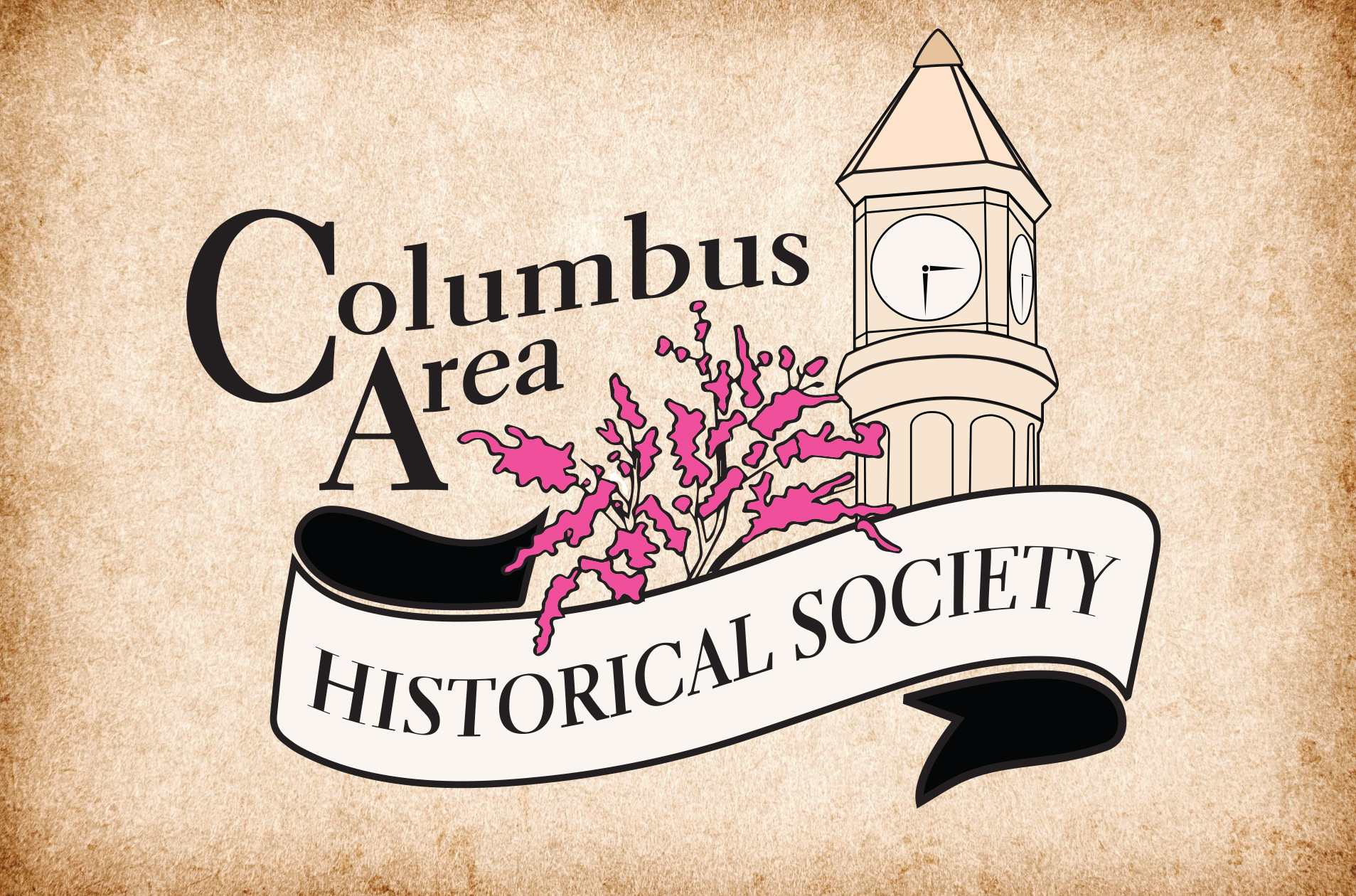Columbus reaches 190 years in 2023
The timeline text was created by Sue Reese for use by Bruce Zahn to teach a Columbus High School history class.
Street-name changes:
1830s
1833 A land survey was completed by the U.S. government of the Michigan-Northwest Territorities. The “Ouisconsin” landscape consisted primarily of burr oak, white oak, black oak, redroot willows, marshland 10 inches deep, and some open prairie and hills.
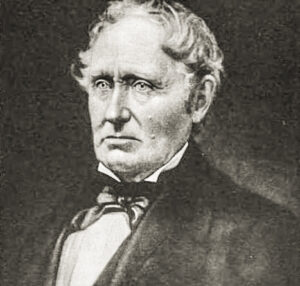
1836 In July 1836 the western counties of Michigan were split off to form the Wisconsin Territory, which included present-day Iowa and Minnesota as well as those parts of North and South Dakota that lay east of the Missouri River. Land was purchased in what would become the Columbus area by Lewis Ludington along with his nephew Harrison and brother James at the land office in Green Bay, with John Hustis. They paid $1.25 per acre for 960 acres – eight parcels bordering the Crawfish River. Hustis, 26, also purchased eight parcels east of that area for his own settlement, Hustisford.

1838 Lewis Ludington leased 1,300 acres to Elbert Dickason on a four-year contract.
1839 Elbert Dickason established the first log cabin and began building a dam across the river. The cabin stood just north of what is currently 409 N. Ludington St., directly across from where the rail depot currently stands. During the summer of 1839, Dickason platted 12 lots across the river from his cabin and north up the hill to what is currently 100 APC Way. The first winter was very severe, with stock starving and wild game scarce. Dickason had grown a crop of wheat, which he had stacked for the winter. He returned to Illinois for the last part of the winter, hoping to restart in spring 1840. When he returned with his wife and family, he found all the stacked wheat had been burned.

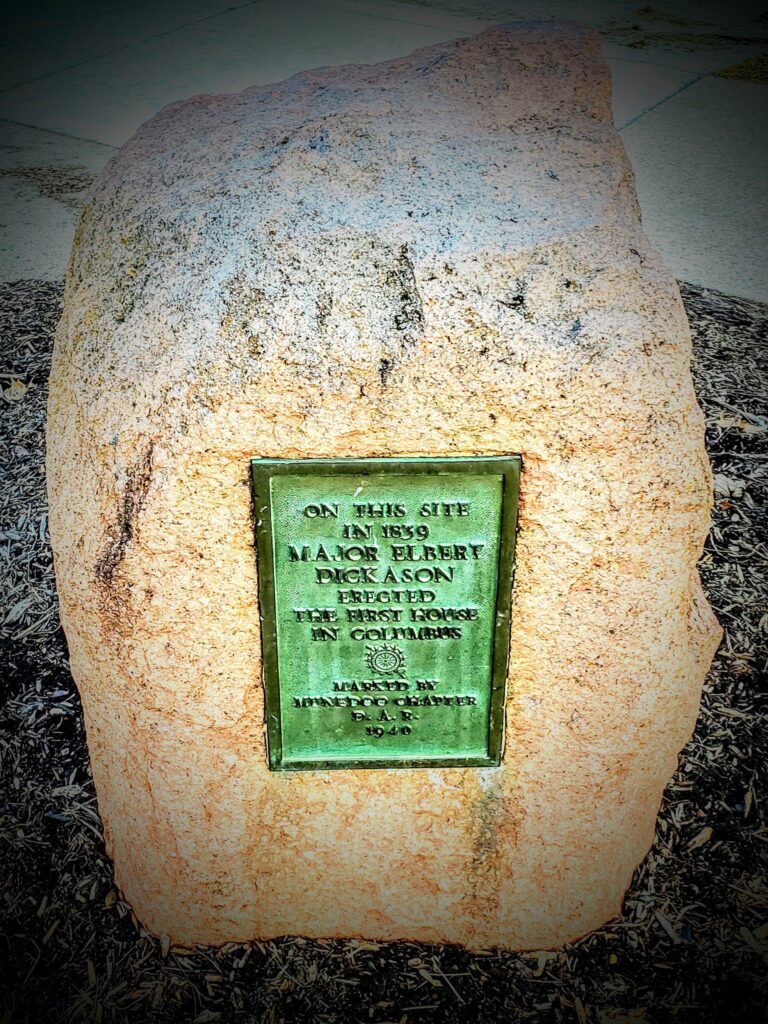


Postcard images are from the Columbus Area Historical Society collection at the Columbus Public Library in partnership with Recollection Wisconsin
1840s
1840 Using $10,000 of his own funds, Elbert Dickason built a sawmill and then shortly thereafter a grist-flour mill. But he didn’t make any payments to Lewis Ludington and John Hustis.
1844 Lewis Ludington platted nine downtown lots in the now-named village of Columbus. Elbert Dickason’s favorite city was Columbus, Ohio, so he thought to honor his family’s old home by naming their new home Columbus. The first businesses were located on what is currently East James Street. The first “official” platted portion of the village was registered with the land office in Green Bay as being in Portage County.
The streets of Columbus don’t follow the cardinal compass points of east, west, north and south. They are laid at 47.5 degrees off the east-west axis; they were laid out that way by Lewis Ludington as he platted the original nine lots of the village. He followed what was known as the Madison Ridge, a ridgeline following the trail toward Madison.
James Street, east and west, was originally about 6 feet lower than it is currently. The road has been raised through the years to accommodate storm sewers. Many of the lower entrances were closed off though remnants of some are still visible currently when looking at the sidewalk next to buildings.
Lewis Ludington and John Hustis became impatient waiting for payment on the land contract with Elbert Dickason; they paid him $600 to leave. Col. Jeremiah Drake and his son William became the new owners of the dam and mill operation. The Drakes built the first frame house in the village near the mill. The first recorded business was Drake & Sons Provision Store, located next to the river near the dam.
Ludington gave the village some land for a cemetery. The first burial was Hiram Allen in 1845. The village controlled the land and burials, rather than the many scattered family and church cemeteries throughout the countryside.
1845 Henry A. Whitney built a 1.5-story frame building at the corner of James and Ludington streets, and opened a tavern-dry goods store-post office-boarding house.
There was a public well in the middle of the intersection of James and Ludington streets – called the “four corners.” There was a fountain for people and troughs for horses, with a drinking pan for dogs at the bottom.
The first buildings at the “four corners” were the Whitney Hotel, the Jones Drug Store at what is now 100 S. Ludington, the Corner Drug Store – which had an oyster bar in the lower level – and the Sargent Block at what is now 101 E. James St.
Daniel Bassett and Josiah Arnold arrived from Janesville. They built a business of commission and dry goods opposite Henry Whitney on East James Street. Their clerk was Uriah Davies.
James T. Lewis, lawyer and eventual governor of Wisconsin, arrived on the same day as Dr. James C. Axtell, the first doctor.

James Taylor Lewis was born in Clarendon, New York. He taught school briefly and went on to study law with former New York Gov. Henry R. Seldon. In 1845 he moved to Columbus, Wisconsin, where he was admitted to the bar. Between 1846 and 1852 he served as District Attorney and County Probate Judge. He was a member of the Constitutional Convention of 1847-1848 from Columbia County. He also won a seat in the State Senate and was elected Lt. Governor, serving from 1854 to 1856. In 1861 he was chosen by the Republican Party to run for Secretary of State, winning the election. In 1863 the Union Republicans nominated him for Governor, and he defeated his Democratic opponent. He was concerned during his tenure with providing sufficient troops for the Civil War, and helping to protect them and their dependents. He visited troops in the field and helped establish hospitals in Wisconsin for the care of the wounded. Refusing renomination in 1865, he was offered a diplomatic post by President Abraham Lincoln. But he chose instead to return to his law practice in Columbus. — National Governors Association www.nga.org

Postcard images are from the Columbus Area Historical Society collection at the Columbus Public Library in partnership with Recollection Wisconsin
1846 Jeremiah Drake opened the first school building on top of the hill where currently School and Ludington streets meet. The school was previously located in a blacksmith’s shop; there were seven students.
1847 The Whitney building burned to the ground. It was immediately rebuilt by new owner Almon P. Birdsey. Part of the building was located across the street as a dry goods store. Birdsey was a wealthy farmer turned businessman.
1849 Joseph Manning bought the mill for $9,000. He made big upgrades to the grinding stones.
The Richmonds came to town. They were a wealthy farming family; children Ezra and Lucy were teachers. In the 1860s what was known as Railroad Street was renamed to Richmond Street to honor the family.
1850s
1850 The census showed 164 males and 124 females in the village. Including the township, Columbus had 960 citizens.
1853 Adolphus Ingalsbe came to Columbus after striking a fortune in the Gold Rush. He was a wealthy land buyer, stock dealer and businessman. He purchased most of the lots from Ludington Street toward what is currently the park. He built a large house at the corner of Fuller Street and Park Avenue.
1855 The first Republican Journal newspaper was started by Daniel Mallo and Delancey Thayer. Their competitor was the Columbus Democrat, owned by George Griswold. Griswold, who was blind, built a big house at 146 S. Dickason Blvd., making it exactly like the house he had in New York.
Emmons E. Chapin, a lawyer and politician, came to town; he was eventually elected as a village supervisor.
1856 Lots were platted by Joseph Manning on the lower side of the village. He spent money faster than he was making it and was deemed a financial mess.

1857 The Whitney building burns down again. By that time Henry Whitney had regained possession of the building. The building was rebuilt in less than a month, this time of Watertown cream-colored brick.
The railroad came to town from Watertown as an extension of the Milwaukee Road. A turntable was located at the end of what is currently Williams Street to spin the engine around to head back to Watertown – because the road didn’t yet go through the “Portage.”
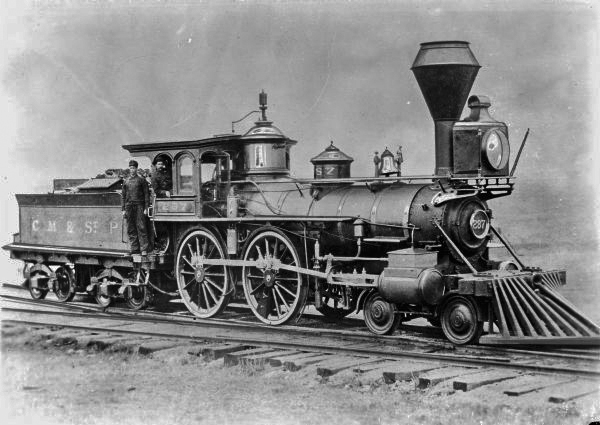
| The Chicago, Milwaukee and St. Paul Railway engine #287 was built by Mason Locomotive Works in 1860. Two men are standing on the locomotive. — photographer Roy L. Wilson. Wisconsin Historical Society, Image #142061 |
1858 Fredrick Farnham and James Allen opened the Farnham & Allen Commission and Warehouse Store across from the Whitney building. They also constructed a grain elevator by the railroad depot.
Lucius Fuller & Son was established as a merchandising business in a building close to what is currently 100 S. Ludington St.
1859 John Henry Kurth arrived with a four-barrel brewer to establish Kurth Brewery, the longest-running in Columbus. The Brauchle family had an earlier brewery, which was much smaller, near the river. The Kurth Brewery complex became one of the city’s largest industries.



1860s
1860 A brick school building was erected on Broadway Street, which later became Dickason Boulevard. The teachers were E. E. Randall, who was paid $106 for four months, and Agnes Butts, who was paid $56 for five months.
1861 War was declared in April. James T. Lewis, Delancy Thayer and Willard Scott Jr. – from the Union Bank – were assigned by the governor to train the Union Guard.
Reuben W. Chadbourn bought out the Vosburg & Sprague bank to open the First National Bank.
John Russell Wheeler arrived from Kenosha, Wisconsin, to open the Union Bank, which would become the Farmers & Merchants Union Bank.
The 18th Wisconsin Infantry Regiment, primarily Columbus-area men, were sent to Camp Trowbridge for final training.




1862 The Battle of Shiloh occurred in April; it was the biggest engagement to that time for Wisconsin troops. The 18th Wisconsin Infantry Regiment – with Capt. William Coleman, 1st Lt. Ira H. Ford and 2nd Lt. Ogden Southmayd – were pivotal players in the battle. More than 174 men were lost.
1864 The Sawyer Block was established at 128 E. James St. with the first hardware and glassware store, run by Lewis Sawyer. Sawyer would become the first mayor of the city of Columbus in 1874.
The railroad was extended from Columbus to Portage. The Milwaukee Road went from Milwaukee through Watertown, Columbus, Portage and on to La Crosse. At that time mostly freight was moved; passengers were occasional.
1867 William Turner and Herman Blumenthal established the Turner & Blumenthal Monument Company on East James Street.
1868 Joseph Manning built one of the largest houses in Columbus at the corner of Ludington and Prairie streets.
1870s
1870 Lueders and Krause commission store was opened.
1873 Daniel Bassett and Uriah Davies built a new building up the block on East James Street from the original commission and dry-goods store.
1874 The charter establishing the city of Columbus was signed, with Lewis Sawyer as the first mayor.
1875 Emmons E. Chapin became the president of the school board as the first free high school was opened. There were seven graduates in 1878.
1876 The H. M. Brown building was constructed at 122 W. James St. for a books, stationery and jewelry store, with Hoskins Photography on the second floor. The still-standing building has “HM Brown” and “1876” on its tympanum.
1877 The first volunteer fire department was begun, with three different groups. One was the Germania Fire Company.
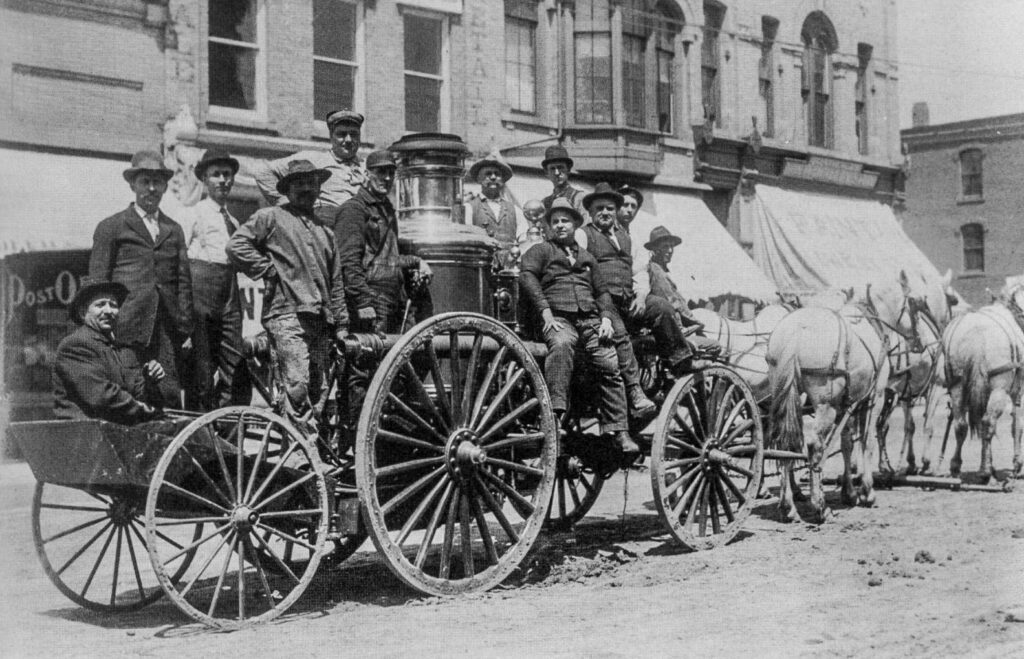

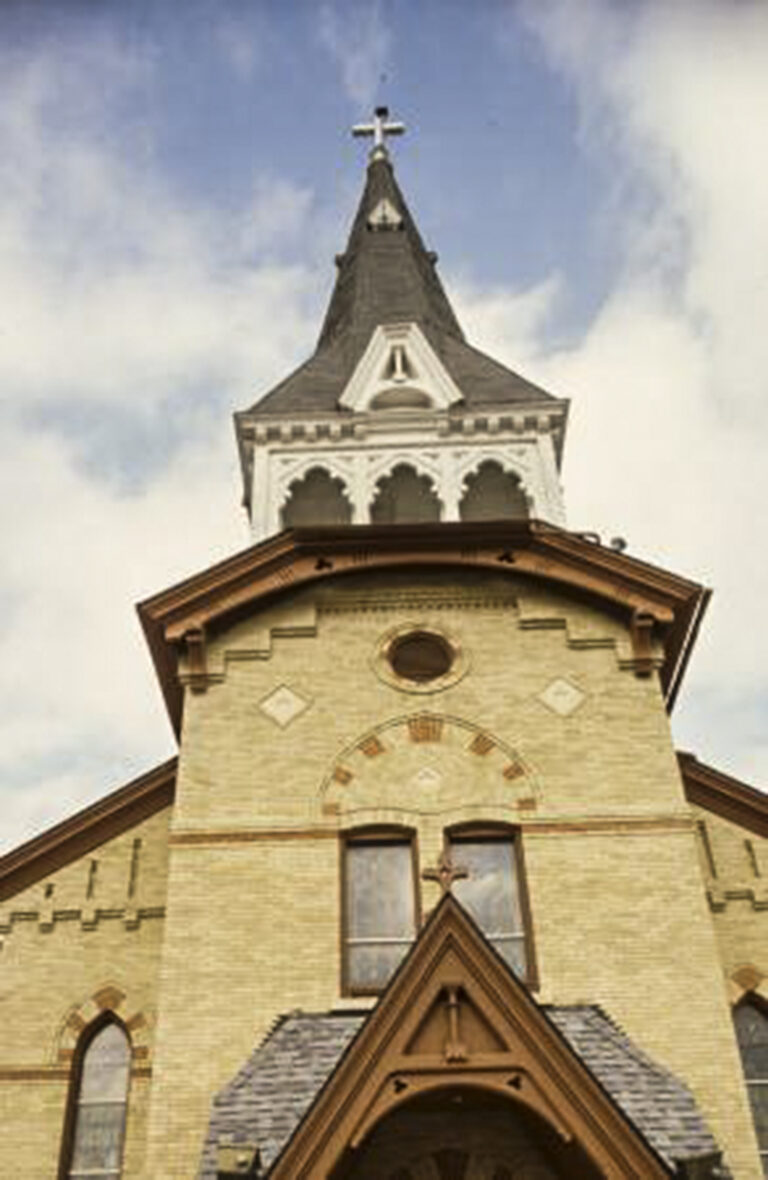
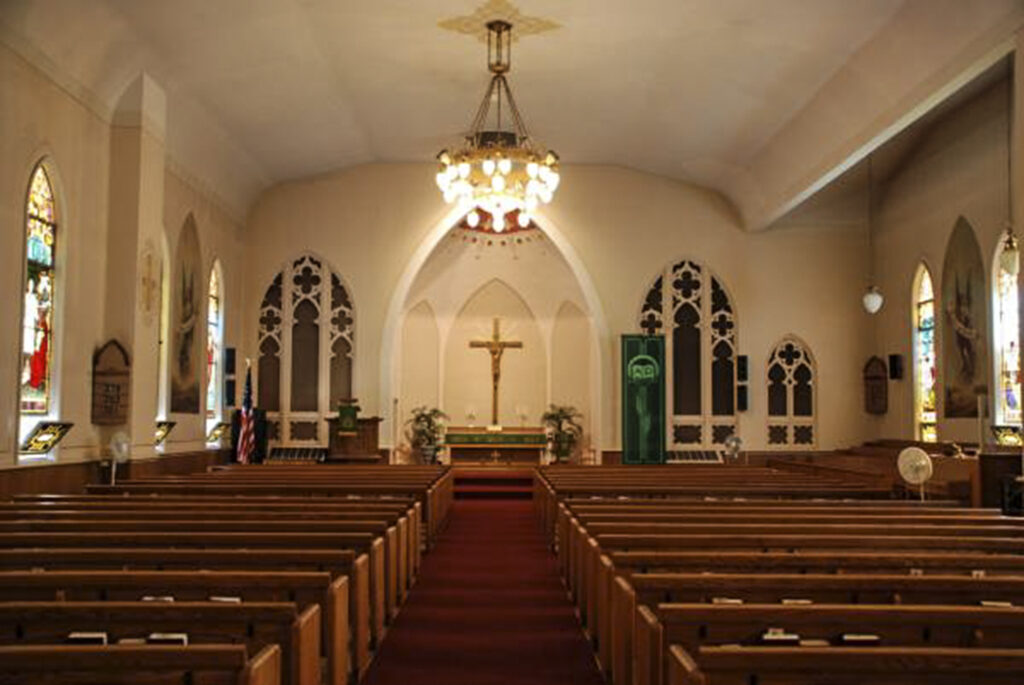
1878 The Zion Evangelical Lutheran Church was built at 254 W. Mill St. in Columbus. The exceptionally fine High Victorian Gothic-style polychromatic brick church was designed by Milwaukee architect Edward Townsend Mix, with Richard D. Vanaken as carpentry contractor and Henry Bolte as masonry contractor. In 1887 an increase in the size of the church necessitated the expansion of the church, which consisted of a 40-foot by 50-foot addition to the rear of the nave in the same style.
The most distinguishing feature of this style is the polychromatic exterior finish. Bricks of differing colors create decorative bands and highlight arches on the building exterior. The wall surface is further decorated with masonry corbelling at the eave line and a rusticated stone foundation. The prominent square open belfry features an arcade of three ornamented trefoil arches on each side. The gabled roof over the entry has a king post truss and barge boards.
The church bell was cast from five cannons captured during the Franco-Prussian War and given to the church by Kaiser Wilhelm, Emperor of Germany. The bell was cast in Baltimore by a German master and weighs 1,600 pounds. On its surface is a Latin inscription, translated as “I call the living, I mourn the dead, I break the lightning!” The steeple was struck by lightning in 1896 and rebuilt.
The church and parsonage are on the state and national registers of historic places. Wisconsin Historical Society Property Record #3502
1880s
1880 John Topp and brothers opened the Topps Dry Good Store on North Ludington Street.
The streets were dirt with wood-plank sidewalks until 1880, when Barr paving bricks from the Barr Clay Company in Streator, Illinois, were placed to make a cleaner and more-attractive uptown area. Uptown East and West James Street, and North and South Ludington Street, received the brick pavers along with concrete sidewalks.
1883 Lewis Sawyer built a new building for a hardware store of brick.
1888 The Griswolds built three buildings for commission and dry goods.
Both Daniel Bassett and Uriah Davies died, leaving William Pietzner as the owner of their commission and dry-goods store. Fred Kettlehon became a partner; the business was renamed Pietzner and Kettlehon Dry Goods & Mercantile.


1890s
1892 The Hotel Tremont was built at 143-147 N. Ludington St. According to its owner in 2015, the original owner also owned the building next door; a second-floor door connected the two. The hotel had 28 rooms; its first-floor restaurant was elegant with white tablecloths.
Columbus City Hall was constructed, housing the fire department, the police department, a second-floor 400-seat auditorium and the first kindergarten. The auditorium hosted movies, plays, business presentations and graduations until 1932, when it was closed because of deterioration. The clock tower and bell were donated by Catherine Chadbourn – wife of R.W. Chadbourn of the First National Bank – as a gift to the city. There was a fountain in front of City Hall for people and pets. That fountain was given to the war effort during World War II; it was melted down along with the canon that sat in Firemen’s Park.
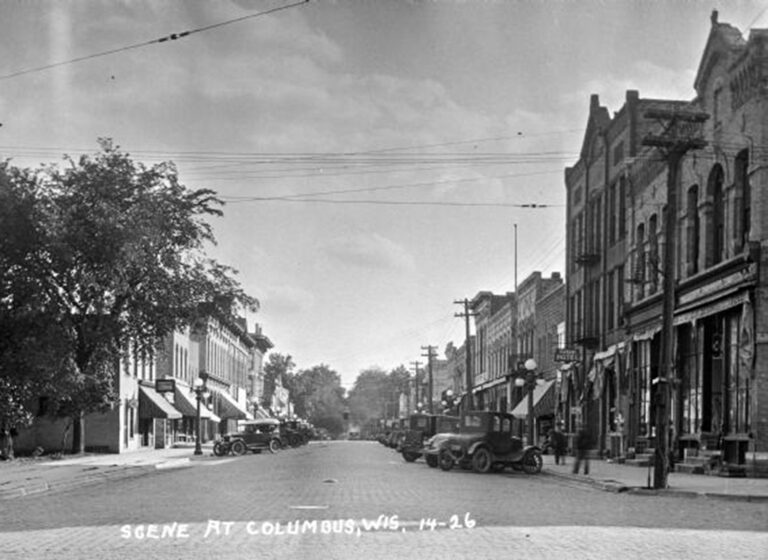
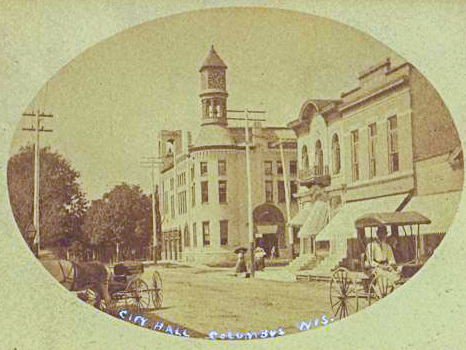
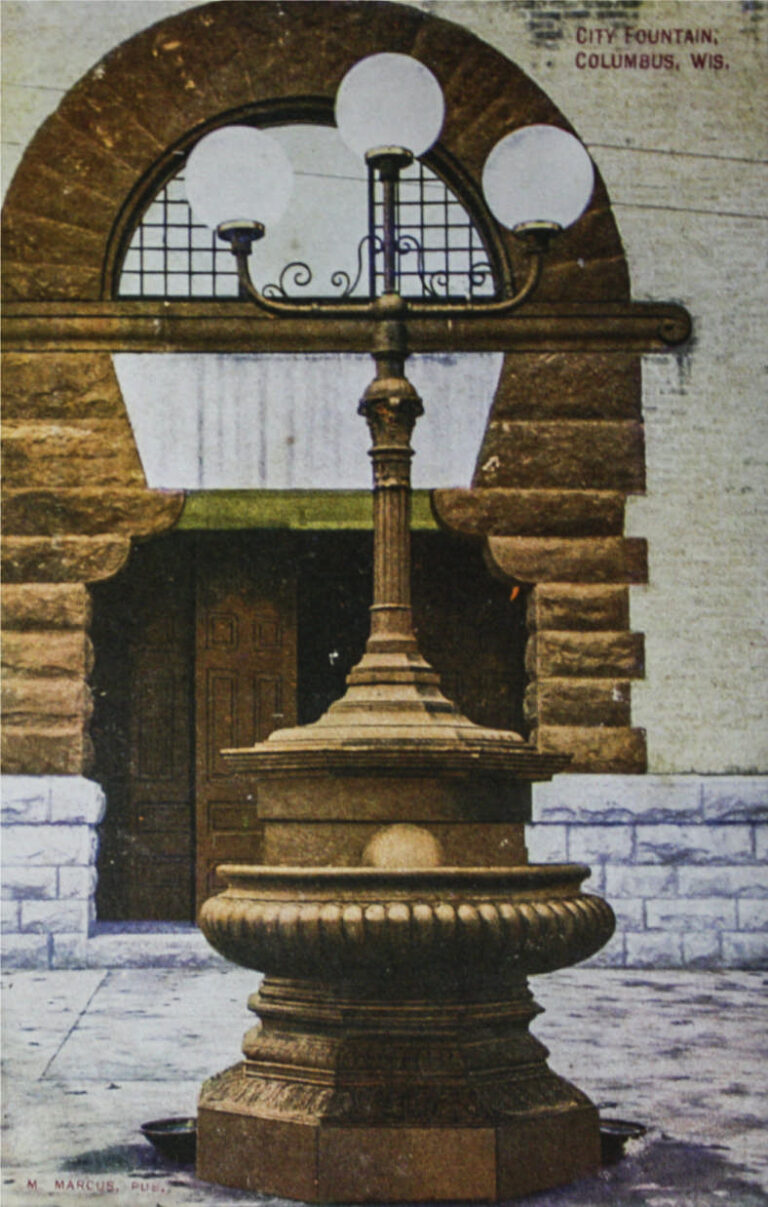

By the late 19th century Columbus had developed into a prosperous rural trading center, its economic wellbeing dependent on the success of the surrounding agricultural community. Columbus’ economic boom of the 1880s and 1890s necessitated additional city services to support the expanding downtown and new residential neighborhoods. The city responded by building a new Columbus City Hall, which opened to the public in 1892.
Truman D. Allen, a Minneapolis architect specializing in courthouse commissions, designed Columbus City Hall. The late-Victorian building is an example of a multi-use municipal building. The offices of city government, the police and fire departments, the jail and fire-fighting equipment, and the city library were located in the building when it opened. On the second floor of the building is a large public auditorium – the location of most of the community’s cultural and educational events. In addition to class plays and graduation exercises, the auditorium hosted traveling theater troupes and served as a motion-picture theater until the local Rudalt Theater was built in 1917.
The city hall is the best local example of the Richardsonian Romanesque style. The style was commonly used for government buildings, where it expressed the stability and permanence of democratic institutions. In the Columbus City Hall it’s characterized by the general massive and heavy appearance of the building, the large arched openings framed in red sandstone, and the contrasting stonework of the lintels, foundation and arches.
The building is open to the public during normal business hours. Wisconsin Historical Society, Record # 79000065
Postcard images are from the Columbus Area Historical Society collection at the Columbus Public Library in partnership with Recollection Wisconsin

1895 A. M. Bellack opened Bellack and Son Men’s Clothiers. The store remained a men’s-clothing store until the 1980s. A. M. Bellack was also one of the organizers of the Columbus Canning Company as well as the Badger Auto Company. Dr. Bernard Bellack, his brother, was a prominent physician in the city.
Turner & Blumenthal supplied marble and dolomite stone for a Civil War Memorial Statue. The soldier was vandalized in 1905; it was replaced with a copper-over-steel statue.

1900s
1900 The Columbus Canning Company was organized, with A. M. Bellack, Fred Stare and other notables. They formed the largest canning company in the nation; peas and corn were the primary commodities. World War II prisoners of war were used as labor during the war years.
1906 A train depot was constructed to make passengers waiting for trains more comfortable.


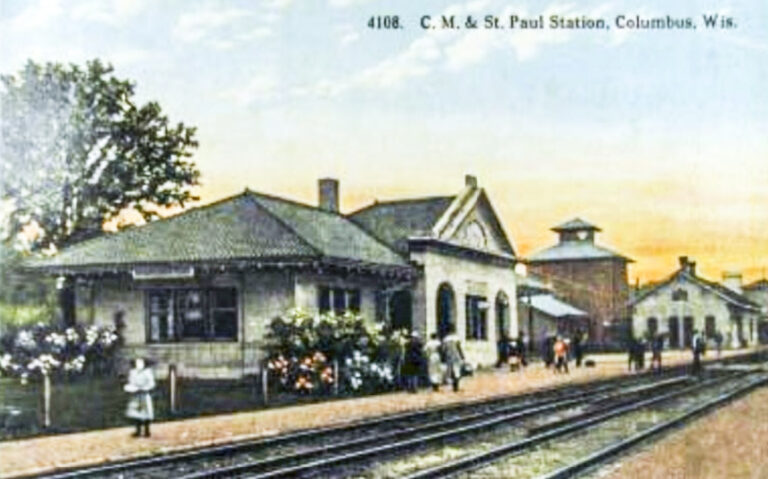
Postcard images are from the Columbus Area Historical Society collection at the Columbus Public Library in partnership with Recollection Wisconsin
1907 The first hospital was constructed by Dr. Bernard Bellack and Catherine Chadbourn on West James Street. It had 15 beds and looked much like a large house. A neighboring house was purchased to serve as nun quarters when the Columbus hospital was sold to the Divine Saviors. It then became known as St. Mary’s Hospital.
1908 Guy Dering ran a successful commission store located at 153 N. Ludington from 1908 to 1921. He was a champion trap shooter and held the world record in 1927, according to the local newspaper at that time. The business took up the entire east end of North Ludington, from the corner to the Hotel Tremont, located at 143-147 N. Ludington St.
1909 The Badger Auto Company was formed. It was short-lived, going into liquidation in April 1911. According to Wikipedia, there were 237 cars produced; they were 4-cylinder 3-speed manuals, with one model having a 112-inch wheelbase and the other having a 110-inch wheelbase. The last Badger Auto Car known in existence is housed at the Wisconsin Automotive Museum, 147 N. Rural St., Hartford, Wisconsin.
An article in “Automobile Topics” by E.E. Schwarzkopf, 1909, says, “The Badger Automobile Company, of Columbus, Wis., recently organized with a capital of $50,000 paid-up capital and $100,000 capital stock, has elected the following officers: A.M. Bellack, president; C. Kurth, vice-president; George Holtz, secretary; J. R. Wheeler, treasurer. Directors – Messrs. Bellack, Kurth, Holtz and William C. Leitsch. M. R. Argobast, designer of the Badger car, which will be manufactured by the company, has been elected general manager of the company. C. Kurth is president of the big Kurth brewing interests, and the other officers are leading business men and manufacturers. The company plans to manufacture 250 cars for 1910 delivery.”
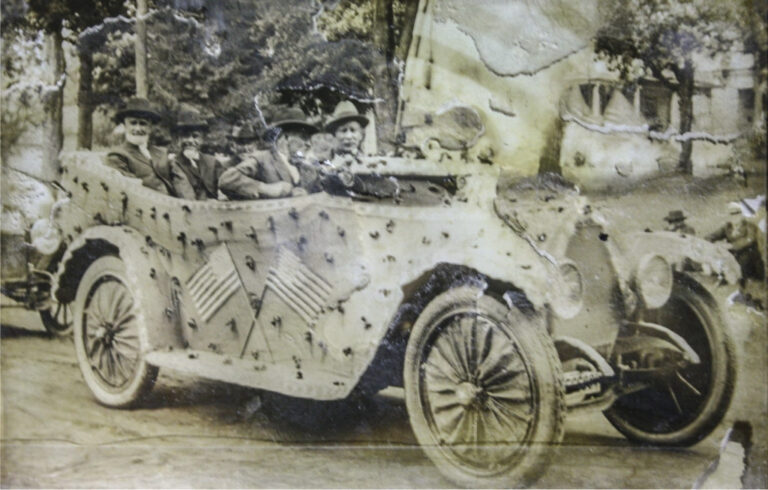

1915 Land became a city park, with its address currently 1049 Park Ave. The fire department developed the park as a community project; it was well-used for many activities. A swimming pond covered much of the lower area near the creek and in back of a baseball field. It had a sand bottom, hauled in for the shallower areas, and a diving platform that was reached by a boardwalk pier. A large grandstand stood by the baseball diamond, with seating for more than 100 people; all were protected by wire fencing. A concession stand stood nearby. A race track for cart and horse racing was located on the green area just across from the pavilion, which was built in 1917. At one time the pavilion had a roller-skating rink on the second floor. The floor was brought in each Friday for Saturday and Sunday roller-skating. Columbus was a hotbed for horseracing. Big-name racers came from Leffingwell Farms, located just outside the city limits, and the Underdahl Farm. The Roys Brothers raised Percherons for both work and show. The farm buildings from the Roys Brothers Horse Plantation still exist at the end of Fairway Drive at Park Avenue.
From the Wisconsin Historical Society ... At the turn of the 20th century the single city park in Columbus lacked any recreational improvements and was inadequate to serve the rapidly growing population. Citizens began agitating for more parkland in 1915, and were successful in winning a budget allocation to purchase land eight blocks from the city center. Plans became more ambitious when the local volunteer fire department adopted the park as a civic project. Construction of the park was a community endeavor, with improvements mostly funded by donations and much of the work conducted by local volunteers.
In June of 1917 the community dedicated its impressive wooden park pavilion with a record-breaking dance event. Seen as a wholesome alternative to the rowdy and bawdy private dance halls, the dances at what would come to be called Fireman’s Park were chaperoned by volunteer firefighters who upheld community morals. At 35 cents per dance, hundreds attended each event, making the park a centerpiece of community life. The park pavilion hosted many other types of community events from exhibits to performances.
Local druggist James Quickenden funded the 1923 Prairie School building to serve the growing numbers of “tin-can” tourists, who found the park an idyllic location for the new recreational pastime of auto touring. Called “Rest Haven,” the building, designed by noted Wisconsin architect Alfred C. Clas, provided sanitation and cooking facilities for visiting tourists.
The park continued to grow in size and amenities and still plays an active role in the community. Fourth of July celebrations are still held in the park, and both the Fireman’s Pavilion and Rest Haven are used for public recreation. The complex is listed on both the state and national registers of historic places. Wisconsin Historical Society property record #04000106

Postcard images are from the Columbus Area Historical Society collection at the Columbus Public Library in partnership with Recollection Wisconsin

1917 The Rudalt Theatre was built at 159 S. Ludington for $8,000. It showed current and most popular movie releases; it had popcorn, candy and beverages for its patrons. The name was a combination of the two original owners – Emil Rudolf and Henry “Crafty” Altschwager. It burned in 1941 and was then rebuilt, continuing operation until early 1962.

1920 The Union Bank moved from 156 W. James St. across the street to its current location at 159 W. James St. The new building was designed by Louis Sullivan, the last of eight “jewel boxes” in the country.

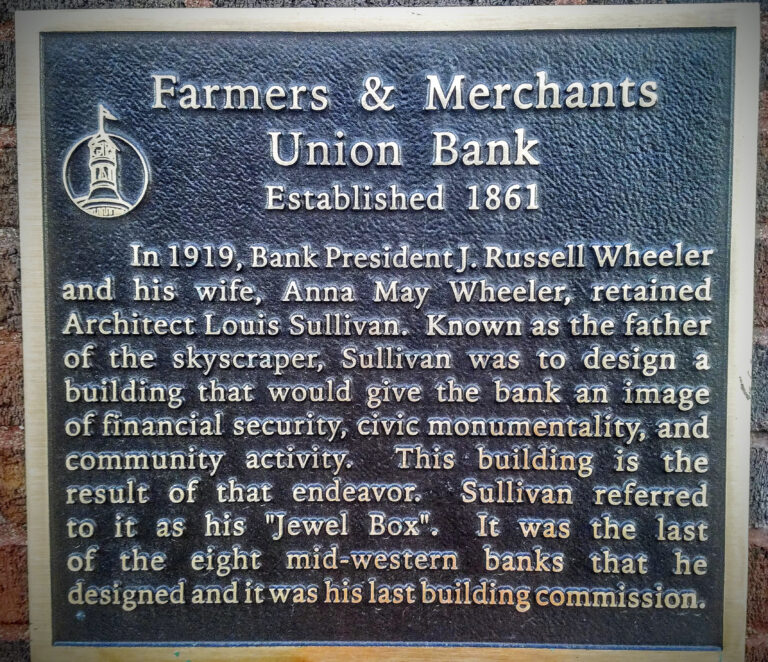

Postcard images are from the Columbus Area Historical Society collection at the Columbus Public Library in partnership with Recollection Wisconsin
1930s Jack A. Winter founded Jack Winter Inc. as a men’s-pant manufacturer. The factory was located at what is currently a parking lot next to 159 W. James St. According to his New York Times obituary, in 1953 he also began to design and manufacture women’s slacks – one of the first in the country. He was part of an investor group that brought the Brewers baseball franchise to Milwaukee. The Columbus factory closed in the late 1960s. He retired in 1986; he died in 1991 at the age of 82.
1949 The “Council Circle” in small Washington Park on Fuller Street was built by the City Beautification Commission. The intent was to honor the Indigenous tribes who used the area for their council meetings and gatherings.
2010 The Columbus Area Historical Society is formed.
